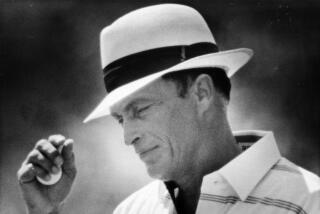Woods Knew Course Load Needed Change
- Share via
So here’s the story: three straight U.S. amateur titles and an NCAA championship. There’s scorched earth in back of you and green pastures in front and they’re throwing so much money at you, it looks like a green blizzard of Ben Franklins.
Tiger Woods did the only thing he really could. He left Stanford early and turned pro.
Now, was that a tough decision?
Duh.
At 19, Woods knew the only courses he was interested in any more were not in school, but the ones he would see on the PGA Tour. As it turned out, Woods was a quick study.
Not only did he win twice and finish in the top 10 three other times in only eight starts after turning pro, but Woods did it in style. Make that financial style.
Woods’ endorsement deals, negotiated by his agent at the time, Hughes Norton of IMG, totaled an unheard-of $43 million--$40 million from Nike and $3 million from Titleist.
Since then, Woods has added such corporate heavyweights as American Express, Rolex and Wheaties to his side of the ledger and his endorsement income has pushed over the $100-million mark.
So, that turning pro thing--tough decision?
“It was the only decision,” Woods said.
Of course, money isn’t the only reason people do anything, it’s just the one we enjoy talking about the most. Woods is a millionaire off the golf course, but he’s also a millionaire because of how he has played while on it. His PGA Tour victory total is nine in less than three years, and it’s 11 if you count his European PGA Tour victories in Thailand and Germany.
He has already won the Masters, he’s a threat to win every time he tees it up and he may be the most feared player in golf. And he’s 23.
Now, that’s how Woods rates as a pro. In college at Stanford, it was clear there weren’t any more challenges ahead for Woods. Turning pro was the only logical step for him.
“There were a lot of different reasons why I turned pro, but the basic one was that I basically had nothing else to accomplish,” he said. “I won three U.S. Junior titles, three U.S. Amateur titles and the NCAA.
“I figured it was time to go. If I had stayed, I figured if anything, I’d probably go downhill. My motivation would decrease. It would be difficult for me to improve. So from a golf standpoint, it was time for me to go. I thought about it for a long, long time . . . and ultimately I made the right decision.”
And who could question that? Not since Jack Nicklaus has a young player left school to make such an impact on the PGA Tour, but Nicklaus did not leave college early. Woods made history when he left Stanford and established new rules for turning pro. Call them the Tiger Rules. No one had seen them before.
“The timing on turning pro, well, everyone’s different,” said Bruce Heppler, Matt Kuchar’s coach at Georgia Tech. “Up until Tiger left, this was a moot point, because nobody left early. Tiger changed things.
“For whatever, the $40 million, whatever, that’s different. I think the dollars that were thrown at him are dollars that probably won’t ever be thrown at anybody again. Tiger had a different experience.”
As a historical contrast, Byron Nelson said his experience was vastly different when he turned pro Nov. 22, 1932.
“The fact is that pro golf, really, in those days was kind of looked down upon as a profession because there really wasn’t any future in it,” Nelson said. “And no money in it, either. You had to have a job or something, a pro at a club, teach a little bit.”
Nelson got a job at the Texarkana Country Club, became an assistant at Ridgewood, N.J., the head pro at Reading (Pa.) Country Club and at Inverness in Toledo, Ohio. Of course, he also went on to win the Masters in 1937 and 1942, the U.S. Open in 1939 and the PGA in 1940 and 1945.
In the beginning of Nelson’s career, being a pro was not exactly a terrific job.
“Pros were rarely allowed in the clubhouse,” he said. “We couldn’t go in there and eat. That’s when I turned pro, my parents didn’t know anything about it except the status of pros in that day. They preferred I do something else . . . almost anything else.”
And in Woods’ case, there was nothing else for him to do except turn pro. As an amateur, he already was a huge name, the corporate endorsements were stacked up like firewood and his talent was so great, success was virtually guaranteed. His time had arrived.
“And I haven’t looked back,” Woods said.
More to Read
Go beyond the scoreboard
Get the latest on L.A.'s teams in the daily Sports Report newsletter.
You may occasionally receive promotional content from the Los Angeles Times.










